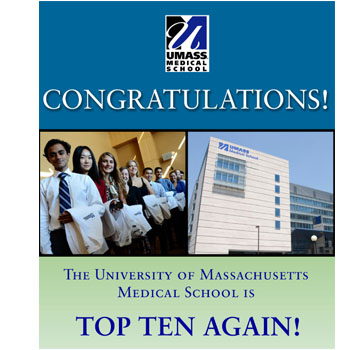 |
UMass Medical School was ranked seventh in primary care education among the nation’s 126 medical schools and 23 schools of osteopathic medicine by weekly news magazine U.S.News & World Report in its 2013 edition of the “Best Graduate Schools” issue, released onTuesday, March 13. UMMS has been listed near the top of the category since 1994, when the magazine began publishing the much-anticipated rankings. Of note, UMMS is the only school in the top 50 that accepts only in-state students into its medical degree program. U.S. News ranked UMMS 48th among top research schools, 79th in nursing and 46th in the biological sciences.
“The University of Massachusetts Medical School is well established as a national leader in primary care education and in research. The quality of the Medical School’s programs in these and other areas is very impressive and very evident,” said University of Massachusetts President Robert L. Caret. “We do, however, always welcome new endorsements and new accolades. While UMass Medical School is still relatively young, it is a shining example of the vision that led to the creation of our system of public higher education 150 years ago, and that is a vision of service to individuals, to communities, to our nation and the world.”
“Our faculty takes great pride in educating and mentoring the next generation of primary care physicians,” said UMMS Chancellor Michael F. Collins. “As we enter a period of unprecedented change in health care, the role of primary care is more important than ever. The part our medical school, faculty and students play in this future has never been more essential.”
UMass Medical School, which had accepted just 100 students per year since the 1970s, expanded the class to 125 beginning with the class of 2013 to help increase the pool of physicians, particularly primary care providers, trained to meet the needs of the commonwealth and the nation. Traditionally, more than 50 percent of each year’s graduates enter a primary care residency program. In addition, more than half of each class stays in the state for residency, totaling 260 new residents in the last five years alone. Graduates of UMMS are poised to excel in their medical careers, and at noon on Friday, March 16—Match Day across the nation—all fourth-year students will discover where they will begin their medical careers.
“These rankings are a testament to the dedication of our outstanding faculty and the passion of our students, who are matching into primary care residencies this week,” said Terence R. Flotte, MD, executive deputy chancellor, provost, and dean of the School of Medicine. “The importance of our mission has never been clearer and these accolades are validation of the rich primary care education our students take with them as they embark on their medical careers.”
The school’s mission, as defined upon its creation by the state legislature in 1962, focuses on providing highly trained primary care physicians to practice in underserved areas of the state. The Medical School welcomed its first class of 16 students in 1970 and celebrated its first commencement in 1974. In addition, the Medical School accepts up to five additional students interested in pursuing an MD and PhD concurrently; such students may be state or non-state residents.
Beyond its core mission of distinction in medical education, UMMS has become an internationally recognized and respected research institute. UMMS also ranks near the top among public medical schools in the Northeast in the amount of funding awarded by the National Institutes of Health. Federal and private research grants and contracts at UMMS rose from about $2 million in 1977 to more than $277 million annually, making UMMS one of the fastest-growing research institutions in the United States.
The U.S.News & World Report rankings of the nation’s 126 medical schools fully accredited in 2011 by the Liaison Committee on Medical Education and the 23 schools of osteopathic medicine fully accredited in 2011 are based on measures of academic quality, which are weighted by reputation among faculty and residents, research activity, student selectivity and faculty resources.
Complete rankings for some specialties have not been released yet. When the information is received, this story will be updated.
Related links on UMassMedNow:
Match Day: A new day for an old tradition
UMass Medical School ranks 8th in primary care education